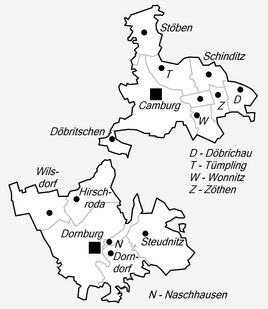Stöben (Dornburg-Camburg)
|
Stumble
City of Dornburg-Camburg
Coordinates: 51 ° 4 ′ 30 ″ N , 11 ° 41 ′ 40 ″ E
|
|
|---|---|
| Height : | 123 m |
| Incorporation : | June 20, 1957 |
| Incorporated into: | Camburg |
| Postal code : | 07774 |
| Area code : | 036421 |
|
Location of Stöben in Dornburg-Camburg
|
|
|
The main street of Stöben
|
|
Stöben is a district of the city of Dornburg-Camburg in the Saale-Holzland district of Thuringia with around 100 inhabitants.
geography
Stöben lies elongated on the left bank of the Saale in a wide valley at an altitude of about 120 meters. The slopes of the Saale valley rise here on both sides about 100 meters above the river. The area around Stöben is primarily used for agriculture.
history
Stöben is mentioned for the first time between 996 and 1002. The next time Stöben is called 1053 and 1116. In 1116, "Stuwi" appeared in connection with the presentation of the Cyriakskirche to the newly founded canon monastery Neuwerk in Halle.
Michael Köhler suspects the Stuwi castle site to be southwest of Stöben on the hill above Schinrode . The favorable place on the tip of the Ilm-Saale-Platte between Stöbener Grund and Saale Valley is particularly suitable for supporting a castle. A whole row of reading stones and a wall-like area of land, which is crossed by a route of a former trade route, indicate this. Since the area has so far remained empty, Köhler's conjecture is only a theory. To the southwest of this area there is a continuous elevation that was interrupted by quarries. It is believed that there are other remains of the fortification there. Small clay and ceramic fragments indicate a settlement of the place in the Bronze Age and Early Iron Age settlement phase. It is believed that this space was used more extensively in the early Middle Ages. It could have been Stuwi Castle, mentioned by Thietmar von Merseburg at the end of the 10th century . Because of the castle and the Cyriakskirche, it is assumed that Stöben was an important hub in the early Middle Ages. Since Stöben was divided into two different parishes until the Reformation and there was no road from Camburg to Naumburg on this bank of the Saale until the late modern era, this is also only theory so far.
Stöben belonged to the Wettin office of Camburg , which was part of various Ernestine duchies due to several divisions in the course of its existence . In the 1420s we received the first news about the inhabitants of the place. In 1826, the place came as part of the Camburg exclave from the Duchy of Saxony-Gotha-Altenburg to the Duchy of Saxony-Meiningen . From 1922 to 1939 the place belonged to the Camburg district department .
The previously independent municipality was incorporated into the city of Camburg on June 20, 1957 , which became the city of Dornburg-Camburg on December 1, 2008 through further incorporations.
Web links
literature
- Ewald Eichhorn : The County of Camburg, (III) as it was, was and is . In: Writings of the association for Saxony-Meiningen history and regional studies - Hildburghausen . 26.1897, pp. 52-71.
- oA: Festival magazine 900 years of Stöben. Holidays from October 6th to October 9th, 1988 . Stöben 1988.
Individual evidence
- ^ The chronicle of Bishop Thietmar von Merseburg and its Korveyer revision, ed. Robert Holtzmann, SS rer. Germ. NS 9, Berlin 1935, p. 203.
- ^ Artur Bierbach (ed.): Document book of the city of Halle, its donors and monasteries 1 (806-1300) (historical sources of the province of Saxony and the Free State of Anhalt NR 10), Magdeburg 1930, p. 17 No. 15c.
- ↑ Michael Köhler: Thuringian castles and fortified prehistoric and early historical living spaces. Jenzig-Verlag Köhler, Jena 2001, ISBN 3-910141-43-9 , pp. 178-179.
- ^ Andrei Zahn: The residents of the offices of Burgau, Camburg and Dornburg: a prayer register from around 1421–1425. AMF publication series; 55; Mannheim, 1998.
- ^ Federal Statistical Office: Municipalities 1994 and their changes since 01.01.1948 in the new federal states. Metzler-Poeschel, Stuttgart 1995, ISBN 3-8246-0321-7 .

